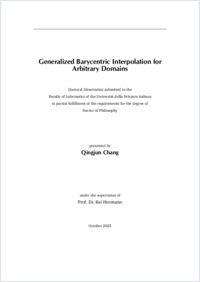Generalized barycentric interpolation for arbitrary domains
- Chang, Qingjun
- Hormann, Kai (Degree supervisor)
- 2025
PhD: Università della Svizzera italiana
Generalized barycentric interpolation
Generalized barycentric kernel
Iterative coordinates
Maximum likelihood coordinates
Image deformation
English
Generalized barycentric coordinates are widely used in computer graphics, geometric modelling, and related fields, owing to their intuitive formulation and favourable mathematical properties, such as linear reproduction, partition of unity, and the Lagrange property. They offer a simple and effective means of interpolating data specified at the vertices of a polygon or polyhedron, a process commonly referred to as generalized barycentric interpolation. Among the various constructions of generalized barycentric coordinates, mean value coordinates are particularly notable for their simplicity and closed-form expression. They are well defined for arbitrary polygons, including non-convex ones. However, in the presence of concavities, mean value coordinates may produce negative coordinate values, which can lead to artifacts in applications such as image deformation and texture mapping. To address this limitation, we propose iterative coordinates, a novel construction based on the observation that the negativity in mean value coordinates often arises from fold-overs in the central projection of the polygon onto the unit circle centred at the evaluation point. By iteratively applying a smoothing operator to the projected cyclic polygon, we are able to reduce and eventually eliminate fold-overs, ensuring the non-negativity of the resulting coordinates. While the method is robust and general, it requires multiple iterations and lacks a closed-form solution. Moreover, the number of iterations required to guarantee non-negativity cannot be determined in advance. Building upon this idea, we also introduce maximum likelihood coordinates, which combine the projection and a single smoothing step from the iterative approach with a new statistical formulation. Instead of maximizing entropy as in maximum entropy coordinates, we maximize the likelihood of the barycentric coordinate distribution for the smoothed polygon. This yields a construction that is not only non-negative and smooth but also possesses desirable properties such as linear reproduction, partition of unity, and Lagrange property. Importantly, this construction requires only one iteration and avoids the computational cost and unpredictability of the full iterative scheme. Furthermore, we demonstrate that maximum likelihood coordinates can be efficiently differentiated, making them especially useful for applications involving gradients, such as finite element methods. We further extend the notion of generalized barycentric coordinates to transfinite barycentric coordinates (also known as transfinite barycentric kernel), which allow for interpolation over curved domains with continuous boundary data. Inspired by the construction of maximum likelihood coordinates, we develop a transfinite framework that yields smooth, non-negative barycentric kernel over arbitrary bounded planar domains. This framework not only includes pseudo-harmonic and non-negative variants of the mean value kernel but also introduces a new kernel that produces interpolants with shape quality similar to that of harmonic interpolants. Experimental results, particularly in image deformation scenarios involving spline-defined domains, confirm that our method offers several advantages over existing approaches in terms of smoothness, robustness, and visual fidelity.
- Collections
- Language
-
- English
- Classification
- Computer science and technology
- License
-
License undefined
- Open access status
- green
- Identifiers
-
- NDP-USI 2025INF015
- ARK ark:/12658/srd1332969
- URN urn:nbn:ch:rero-006-123320
- Persistent URL
- https://n2t.net/ark:/12658/srd1332969
Statistics
Document views: 54
File downloads:
- 2025INF015: 166
